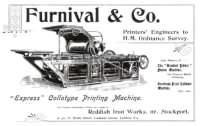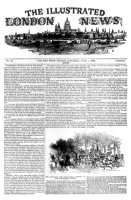The History of Photography - Photographs in Print
|
Photographs in Print |
- Introduction
- Early Printing Processes
- First News Pictures in Print
- Halftone Reproduction
- Lithography and Photography
- Photojournalism
| Photographs in Print - Introduction | Back to the top |
The first book to contain
photographs was the "The Pencil of Nature" by William Fox Talbot, about
150 copies were made between 1844 and 1846. Each photograph in the book
was an original calotype
glued on to the page.
 |
The title page of "The Pencil of Nature", which was published in six parts by Longmans between 1844 and 1846. |
This process of individually
creating photographic prints was very slow. For photographs to be mass
produced in publications such as newspapers, magazines and books a mechanical
form of reproduction was required.
| Early Printing Processes | Back to the top |
The history of "Photographs in Print" starts with processes invented long before the birth of photography.
Paper was invented in China in 105 AD and the oldest known printed book is dated at 868 AD. The words, pictures and symbols used in the Eastern languages were all carved together on wooden blocks. These blocks were inked and impressed on paper, card, animal skin or textiles.
By 1400 Korean printers were casting metal type, but it is Johannes Gutenberg (1398-1468), a German businessman, who is credited with the invention of printing in the West. In about 1440 he developed a technique of producing a number of different letters which could be assembled to form a page of European "writing". Guttenberg’s process was called "letterpress". The invention of printing spread across Europe and in 1476 William Caxton set-up a press in London after learning his craft in Germany.
| Wine-type presses with huge screws, like the one illustrated here, were in common use until the Industrial Revolution when they were replaced by simpler lever mechanisms. |
 |
Woodcuts and letterpress are both relief printing processes, in which the raised surface is inked and pressed against the paper, so they can both be printed together. However woodcuts form a very rough image.
For fine illustrative work the intaglio process, a form of recessed printing, was used. The image was cut into a copper plate by hand. The scored image was filled with ink and the surface then wiped clean. An impression was made by laying a sheet of paper over the plate and pressing the paper to draw the ink from the grooves of the image.
Letterpress and intaglio could not be printed together, therefore the pictures were inserted into books during the binding stage. Intaglio lettering had to be done by hand on the copper plate. This, often elaborate, lettering is now called "copperplate". By the late 19th Century steel plates were used as they were more durable.
Refer to the PhotoScience
- Mechanical Printing section for more technical information about
letterpress
printing.
| First News Pictures in Print |
The first modern news picture
appeared in the "The Illustrated London News" in 1842. It showed
the attempted assassination of Queen Victoria.
| However the picture was simply an artist's impression of what had happened. No camera at the time could have caught the action and there wasn't a mechanical way to reproduce the photograph even if it had been taken. |
Artists at that time would make a sketch of the scene, followed by a more detailed drawing. The drawing would be copied, sometimes in reverse, onto a smooth block of wood. A craftsman would cut away all the surface except the lines to be printed. In these pictures shadows were represented by many small separate strokes.
The finished block would then be pressed into clay, making an impression of the image. Molten type metal was then poured onto the clay making a cast. This cast plate was used in the ‘letterpress’ printing process where raised areas of metal carry the ink.
When photography came into use in the 1840’s it did not alter newspaper reporting because the wood engraving and printing processes of the time could only render solid backs and whites. The intermediate shades of grey found in a photograph could not be reproduced.
Photography simply supported the engraving process by replacing the initial artist drawn sketch of the scene. In 1891 in the USA alone there were 1,000 artists producing more than 10,000 drawings a week for the press.
 |
| The collotype process, also known as ‘photogelatin’, was the first method invented for reproducing photographs but is unsuitable for large print runs. It still is the only process that can produce continuous tone prints without the use of halftones - see the next section. |
| Halftone Reproduction | Back to the top |
The problem with mechanically printing photographs by the ‘letterpress’ process was resolved by the invention of the halftone. The halftone converts the different tones of a photograph into dots of varying size. The eye has limited resolving power and, at a distance, is tricked into seeing these dots as continuous tone.
William Fox Talbot first suggested in 1852 that tones could be reproduced by means of photographic screens. However it was not until the 1890’s that the first halftone photographic reproductions appeared in daily papers, and then it took another ten years before the process was fully adopted.
Halftones were created by using a camera containing a ruled glass screen with a grid pattern to break up the image into tiny dots of different sizes. In 1882 George Meisenbach, following work done by Frederick Ives the previous year, introduced a single lined screen that was turned ninety degrees during exposure. In 1890 Frederick Ives, with Louis and Max Levy, introduced the first cross lined screen. Nowadays halftones are computer generated and are also used for full colour printing.
For more information please
refer to PhotoScience
- Mechanical Printing and the letterpress
or PhotoScience
- Halftone Reproduction.
| Lithography and Photography | Back to the top |
Lithography was the principle printing process of the 20th Century and continues to be so in the 21st Century.
Lithography was developed by Alois Senefelder towards the end of the 18th Century, in around 1798 his experiments with limestone to provide a cheaper alternative to copper plate printing were a failure, but he noticed that he could print without an etched image.
Senefelder’s new process was based on the principle that oil and water do not mix, he found that if a prepared limestone surface was drawn upon by a wax crayon and then soaked in water it could be rolled with a greasy ink, the ink would be repelled by the water and only cover the crayoned areas. An impression could then be made by pressing paper onto the limestone.
Although the term lithography means ‘writing on stone’ from the end of the 19th Century prepared metal plates, originally zinc, replaced the limestone. Metal plates are now commonly made from aluminium with a granular water carrying surface. However metal plates can easily be damaged.
Offset lithography was developed to overcome the limitations of metal plates. It is a process in which the image is transferred from the plate to a rubber roller before the final impression is made. Offset was first used around 1875, but the first rotary offset lithography machine was introduced in 1906.
Typesetting was one of the initial problems with lithography, various ways of creating type were tried including using letterpress. The problem was not fully resolved until the invention of photography in 1839 and its subsequent application to the printing process. Now images are normally transferred to the offset plate photographically. Continuous tone images are converted by the halftone process into a pattern of different sized dots.
The application of photographic techniques to plate production made offset lithography the principle printing process of the 20th Century.
For more technical information
please refer to the PhotoScience
- Mechanical Printing section for lithography
printing or look at the PhotoScience
- Halftone Reproduction page.
| Photojournalism | Back to the top |
Photojournalism was born in the 1920s when the printing technology was mature enough to support mass production. In addition camera development had also progressed and in 1924 the Leica entered the market changing the way many photographers viewed their work. The capabilities of the Leica made a new form of photojournalism possible, as typified by the Magnum photographic agency.
By 1920 Germany produced more illustrated publications than any other country, with titles like the "Berlin Illustrated Newspaper". During the 1930s and 1940s picture magazines thrived. These magazines were possibly the most important persuasive visual medium before television, they included the British "Picture Post" and the American "Life" publications, they had enormous status and were able to mould public opinion.
| Cover of Picture Post,
February 1939 |
 |
 |
|
Photojournalism flourished with picture magazines, however their decline in popularity started in the 1950s, Picture Post closed in 1957 and Illustrated closed in 1958.
Television had started to take over and many advertisers abandoned the picture magazines. By the 1970s photojournalism had lost most of its influence.
 |
|
|
Origins
and History of Photography - Timeline
Photographs
in Print
